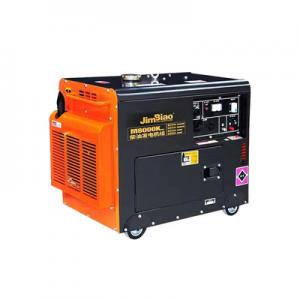
Add to Cart
<1> Overview of generator
Air-cooled diesel generators are a type of generator that uses air as the primary method of cooling the engine. Unlike liquid-cooled generators that utilize a separate cooling system with a radiator and coolant, air-cooled generators rely on airflow and fins to dissipate heat from the engine.
Here are some key features and information about air-cooled diesel generators:
Engine: Air-cooled diesel generators are equipped with a diesel engine as the power source. Diesel engines are known for their durability, fuel efficiency, and ability to provide reliable power for extended periods. They are commonly used in applications where a steady and continuous power supply is required.
Cooling System: Air-cooled generators use a combination of natural convection and forced airflow to cool the engine. The engine is surrounded by fins that increase the surface area exposed to the air. As the generator operates, air is pulled in through the fins by a fan or fans mounted on the engine, allowing heat to dissipate.
Cooling Capacity: The cooling capacity of air-cooled diesel generators depends on the design of the engine and the airflow generated by the fan(s). The cooling capacity determines the generator's ability to handle the heat generated during operation. It's important to ensure that the generator is properly sized for the intended load to prevent overheating.
Noise Level: Air-cooled diesel generators tend to be noisier compared to their liquid-cooled counterparts. The cooling fans can contribute to the overall noise level during operation. However, advancements in engine and fan designs have led to quieter air-cooled generators, and some models may include sound-dampening features or enclosures to reduce noise.
Maintenance: Regular maintenance is crucial for the proper functioning and longevity of air-cooled diesel generators. This includes tasks such as checking and cleaning the cooling fins, inspecting and cleaning the air filters, and ensuring proper airflow around the generator. Regular oil changes, fuel filter replacements, and general engine maintenance are also required.
Applications: Air-cooled diesel generators are commonly used in various applications, including construction sites, remote locations, agricultural settings, residential backup power, and small businesses. They are valued for their portability, ease of maintenance, and reliability in providing power where liquid-cooled generators may not be practical or readily available.
Fuel Efficiency: Diesel engines are known for their fuel efficiency compared to gasoline engines. Air-cooled diesel generators can provide longer runtimes per gallon of fuel, making them cost-effective for continuous or extended use.
When selecting an air-cooled diesel generator, it's important to consider factors such as power output, runtime, fuel efficiency, noise level, and the specific requirements of the intended application. Manufacturers provide specifications and guidelines for proper operation, maintenance, and load capacity, which should be followed to ensure safe and optimal performance.
Working principle of diesel generator
The diesel engine drives the generator to convert the energy of the diesel into electricity. the
In the cylinder of the diesel engine, the clean air filtered by the air filter is fully mixed with the high-pressure atomized diesel sprayed from the fuel injector. Under the upward extrusion of the piston, the volume shrinks and the temperature rises rapidly to reach the ignition point of diesel. When the diesel oil is ignited, the mixed gas burns violently, and the volume expands rapidly, pushing the piston down, which is called 'work'. The cylinders perform work in a certain order, and the thrust acting on the piston becomes the power to drive the crankshaft through the connecting rod, thereby driving the crankshaft to rotate. the
If the brushless synchronous alternator is coaxially installed with the crankshaft of the diesel engine, the rotation of the diesel engine can be used to drive the rotor of the generator. Using the principle of 'electromagnetic induction', the generator will output an induced electromotive force, and a current can be generated through a closed load circuit. .
Only the most basic working principle of the generator set is described here. In order to obtain usable and stable power output, a series of diesel engine and generator control, protection devices and circuits are also required.
| Power series | 6.5KW diesel generator set M8000K | ||
| Model | |||
| Frequency | 50 | ||
| Cont.AC output | KW | 6.5KW | |
| Max.Ac output | KW | 6KW | |
| Voltage(A.C) | 230/400 | ||
|
Type | Self excitation,constant voltage,field rotating,2 pole generator | ||
| Stator size | φ190*148 | ||
| Phase | Single phase/3-phase | ||
| Power factor | c 1.0/0.8 | ||
| Insulation | H(定子/转子 Stator/rotor) | ||
|
Type | Single-Cylinder,Vertical 4-Cycle,Air-cooled diesel | ||
| Model | 186FA | ||
| Bore×stroke | 86*72 | ||
| Displacement | 418 | ||
| Starting system | 电起动 Electric starter | ||
| Lube oil capacity | 1.65 | ||
| Lubrication oil | CF grade or higher(SAE10W/30,SAE15W/40) | ||
| Fuel oil | Diesel fuel (BS 2869 A1 or A2) | ||
| Fuel tank capacity | 8 | ||
| Noise level at 7m | dB(A) | 87~90 | |
| Packing dimensions
(L×W×H) mm | 720*500*620 | ||
| N.W/G.W | 105 | 108 | |

